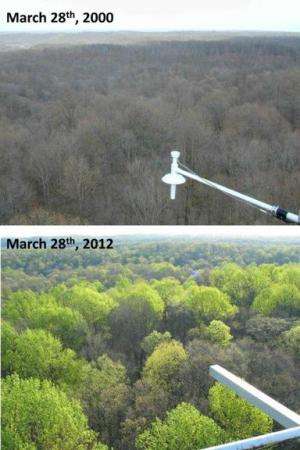Climate change's longer growing season won't mean more carbon capture

Forests may stay green longer due to global climate warming, but it doesn't mean those same forests will actually grow more. In fact, new research in two papers published by scientists at Indiana University finds that even though trees may keep their leaves on longer during warm years, how much they grow depends on how much rain they receive.
And with drier conditions predicted to become more common across much of the Midwest, the degree to which forests can store carbon and slow climate change will be reduced.
When taken together, the two papers published today in Global Change Biology argue that continental-scale satellite data that measures canopy greenness is not an accurate tool for estimating forest photosynthesis and, in turn, tree growth.
"One would expect that having green leaves for a longer period of time would lead to more photosynthesis and, as a result, more carbon available for wood growth every year," said Edward Brzostek, a postdoctoral fellow in the IU College of Arts and Sciences' Department of Biology and first author on one of the papers. "What we find is the exact opposite: Tree growth is declining due to growth ending earlier and earlier each year because the site has been getting drier and drier each year."
Using tree growth data from Morgan-Monroe State Forest in Indiana, coupled with regional data from the U.S. Forest Service, Brzostek was able to estimate the potential impacts of water stress at a regional scale using the record of growth for about 300,000 trees representing dozens of species.
"Many of the tree species that we found to be most sensitive to water stress are actually the ones that are poised to become increasingly dominant over the next several decades," said Richard Phillips, assistant professor in the Department of Biology at IU and co-author on both studies. "Sugar maple and tulip trees represent the future forest for many regions around the Midwest as oak trees continue to decline, but these trees are not well-adapted to deal with water shortages and thus will take up much less carbon in a drier world."
Chronic water stress could potentially reduce the carbon sink of deciduous forests in the U.S. by as much as 17 percent in coming decades, leading to a decrease in carbon capture that translates to an additional one to three days of global carbon emissions from fossil fuel burning each year, according to the paper, "Chronic water stress reduces tree growth and the carbon sink of deciduous hardwood forests."
In a companion study—"An improved approach for remotely sensing water stress impacts on forest C uptake"—IU researchers reported a promising new method for detecting the impacts of water shortages on forest growth across large regions.
Using national satellite data and detailed site data from Morgan-Monroe and from the University of Missouri Baskett Wildlife Research area in the Ozark region of central Missouri, the team found that forest canopies do not change greenness—or "brown down" like a residential lawn would with drought—as photosynthesis declines.
A better barometer of what was happening within forests was information gathered from the patchwork of grasslands and agricultural fields that exist in and around the majority of forests, said Daniel A. Sims, first author on the paper and an IU College of Arts and Sciences' Department of Geography postdoctoral fellow.
"Those ecosystems—those adjacent grasslands and fields—do 'brown down' with drought, and we were able to show that we could better predict the impacts of drought on photosynthesis in forests if we used those agricultural fields as 'eco-meters,'" Sims said. "The browning down of agricultural fields was directly correlated with forest photosynthesis at both Morgan-Monroe and in Missouri."
Leveraging agricultural fields as eco-meters could aid researchers in better understanding the interaction between tree species and drought response, in turn providing tools for developing plans for how forests can be managed to become more drought resilient, they said.
"What's most important is that both studies highlight water as an important constraint on the ability of forests to remove carbon from the atmosphere," Brzostek said. "Leaves may be staying green longer with warmer temperatures, but if our future climate is warm and dry instead of warm and wet, it is unlikely that forests can continue to offset our fossil fuel emissions at the same rate."
More information: "Chronic water stress reduces tree growth and the carbon sink of deciduous hardwood forests." Brzostek ER, Dragoni D, Schmid HP, Rahman AF, Sims D, Wayson CA, Johnson DJ, Phillips RP. Glob Chang Biol. 2014 Jan 13. DOI: 10.1111/gcb.12528.
Journal information: Global Change Biology
Provided by Indiana University




















